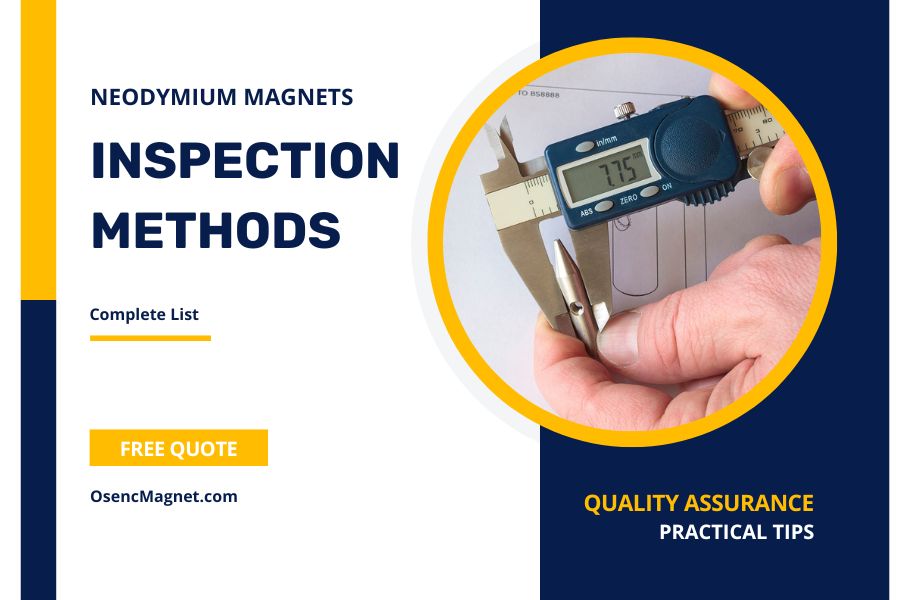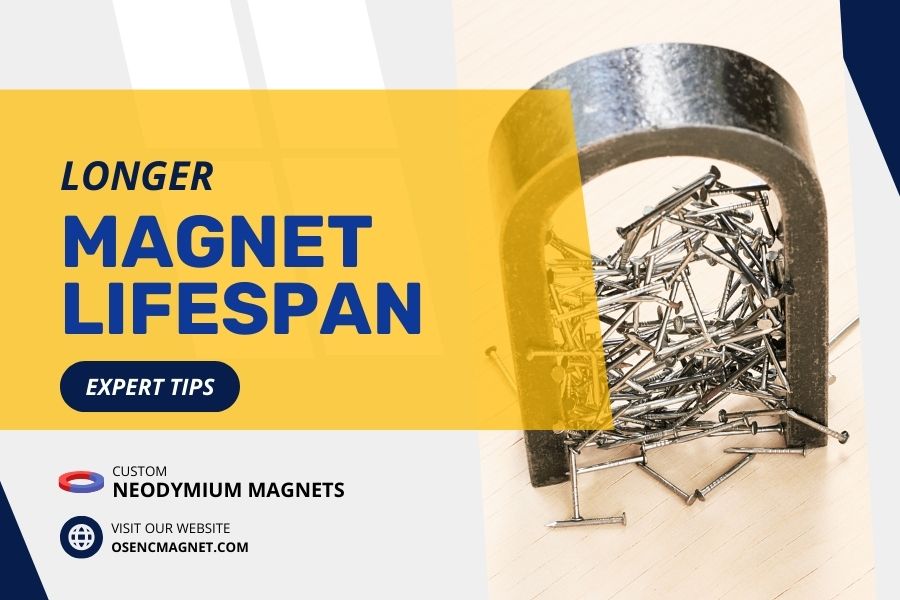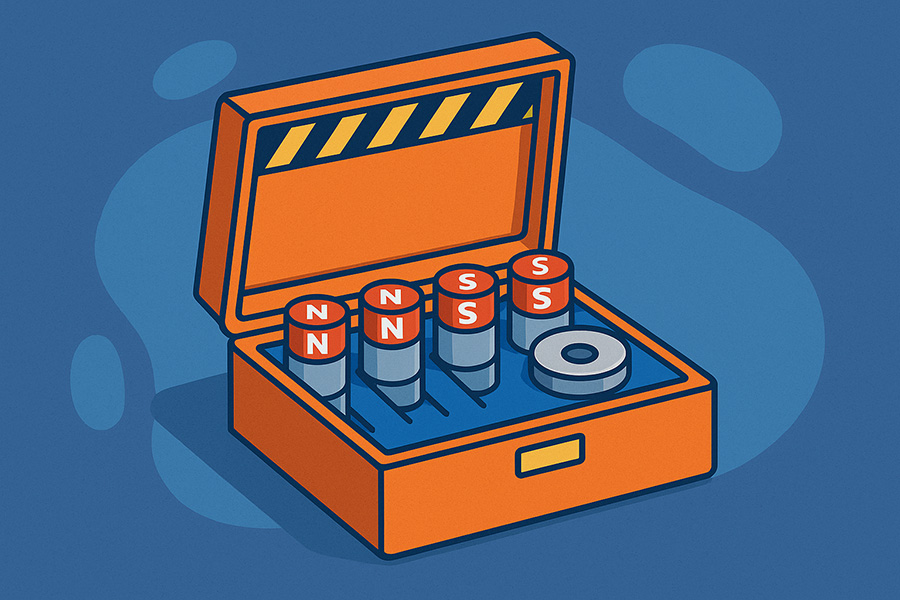New to neodymium magnets?
These powerful little magnets (also called NdFeB or rare earth magnets) are the strongest permanent magnets you can get.
But how do you know if you’re getting good ones?
This guide walks you through simple ways to check magnet quality for your projects.
Table of Contents
Why Quality Matters
Bad magnets can:
- Lose strength too quickly
- Break when you need them most
- Corrode fast
- Fail in your application
Let’s look at how to catch these issues before they become problems.
Understanding Magnet Grades and Ratings
Before checking magnets, you need to know what you’re buying.
Neodymium Magnet Grades Explained
Neodymium magnets come with labels like N35, N42, or N52.
The “N” number shows the magnet’s maximum energy in MGOe (Mega-Gauss Oersteds) – basically how strong it can be.
Higher numbers mean stronger pull:
- An N52 gives about 50% more pull than an N35 of the same size
- Most commercial magnets range from N30 to N52
- Higher grades (N50-N52) cost more and can break easier
Letters after the number tell you how much heat they can handle:
- No letter = Standard (up to 80°C/176°F)
- M = Medium (up to 100°C/212°F)
- H = High (up to 120°C/248°F)
- SH = Super High (up to 150°C/302°F)
- UH = Ultra High (up to 180°C/356°F)
- EH = Extremely High (up to 200°C/392°F)
- TH = Thermal High (up to 220°C/428°F)
For example, an N42SH magnet has about 42 MGOe strength and works in temps up to 150°C without losing much magnetism.
Temperature Effects on Magnets
- Temporary Losses: All neodymium magnets lose some strength when they get warm – about 0.12% for each °C temperature increase. This comes back when they cool down.
- Permanent Losses: If they get too hot (above their max rating), they lose strength forever unless you remagnetize them.
Pro Tip:
- Always pick a magnet with a temperature rating at least 20°C higher than your expected environment.
- This gives you a safety buffer.
Visual and Surface Inspection
Your first quality check is simple – just use your eyes!
What to Look For
Good neodymium magnets should have:
- Smooth, even surfaces
- No cracks or chips
- Even color without rust spots
- Clean, uniform coating
- Sharp, clear edges (unless deliberately rounded)
- Same appearance across all pieces in your batch
Neodymium magnets rust easily, so they almost always have a protective coating. The most common is nickel-copper-nickel (NiCuNi), giving a shiny silver look. Other coatings include zinc (duller silver, cheaper), tin (bright silver, food-safe), gold (for decorative uses), or epoxy resin (often black, great protection against corrosion and chipping).
Pro Tip:
- Use a magnifying glass to spot tiny defects that could cause problems later.
- Look for small cracks, pinholes, bubbles, or peeling.
- Check the edges and corners closely – they tend to have the most coating problems.
Testing Coating Quality
The coating quality matters as much as the magnet itself.
Try these tests:
- Tape Test: Press adhesive tape firmly on the magnet and pull it off quickly. No coating should come off with the tape.
- Cross-Cut Test: For better testing, some suppliers cut a grid pattern (1mm squares) on the surface before applying tape to see if the coating lifts at the cuts.
- Visual Check: The coating should be even with no bubbles, cracks, or peeling. Nickel should be bright; zinc might look a bit more matte.
- Thickness: While you can’t measure without special tools, good nickel-copper-nickel coatings are typically 15-25 microns thick.
Professional checks often include:
- Salt Spray Test: Good coated magnets can survive 24-48 hours in salt fog without rust spots. Premium coatings may last 72+ hours.
- Humidity Test: Magnets get exposed to high humidity (95%+) and heat (60-80°C) for days to check corrosion resistance.
- Edge Coverage: Manufacturers pay special attention to edges and corners since they’re most vulnerable. A good coating wraps around all edges completely.
Dimensional Accuracy
Perfect measurements ensure your magnets will fit where you need them.
Measuring Your Magnets
Basic tools like calipers work well for simple checks. Measure:
- Length, width, and thickness for block magnets
- Diameter and thickness for disc magnets
- Inner diameter, outer diameter, and thickness for ring magnets
Understanding Tolerances
Good sellers provide tolerance measurements. Typical tolerances for neodymium magnets range from ±0.03mm to ±0.15mm (±0.001 to ±0.006 inches).
- Smaller magnets usually have tighter tolerances (around ±0.05mm)
- Larger magnets might vary more (±0.1mm or ±0.15mm)
- Thickness often has tighter tolerances than length or width
Some examples by size:
- A 5mm × 5mm × 2mm magnet: typically ±0.05mm (so 4.95-5.05mm in any dimension)
- A 10mm × 10mm × 3mm magnet: typically ±0.05mm to ±0.1mm
- A 50mm × 50mm × 10mm magnet: typically ±0.1mm to ±0.15mm
Common Issues to Check:
- Uneven thickness across a disc (measure at several points)
- Out-of-round cylinders (measure diameter in multiple directions)
- Size differences within a batch (compare several pieces)
- Flatness problems (place on a flat surface and check for rocking)
- Parallel issues (stack magnets and look for gaps or wobbling)
For critical projects, manufacturers use precision tools like:
- Micrometers for thickness (accurate to 0.001mm)
- Height gauges for consistent measurements
- Coordinate measuring machines (CMM) for complex shapes
- Dial gauges on surface plates to check flatness (to 0.01mm)
- Roundness testers for cylindrical magnets
When ordering, specify tolerances if your project needs exact sizes.
A quality supplier ensures consistent sizes throughout your order and can provide measurement records if you ask.
Magnetic Strength Testing
This is why you’re buying these magnets in the first place – they’re incredibly strong!
Strength Tests You Can Perform
As a buyer, you can do these basic checks:
Pull Force Test
How much weight can the magnet hold? Quality magnets match their stated pull force. Test this with:
- A simple spring scale or digital hanging scale
- A steel plate at least 10mm thick (thinner plates reduce pull force)
- Place the magnet on the plate, attach the scale, and pull straight out
- Record the peak force just before it separates
Typical pull force values for quality magnets:
- 10mm × 5mm N42 disc: about 3.5-4 kg pull force
- 20mm × 10mm N42 disc: about 11-13 kg pull force
- 10mm × 10mm × 10mm N42 cube: about 6-7 kg pull force
Comparison Test
If you have known good magnets, compare them with your new ones by:
- Stacking identical magnets and measuring how much force is needed to separate them
- Measuring the distance at which they attract a steel object
- Testing how many paper sheets they can hold against a refrigerator
Repulsion Test
Place identical magnets with like poles facing each other.
They should repel at consistent distances if their strengths match.
Professional Testing Methods
Professional manufacturers use sophisticated equipment:
Gaussmeter Testing
Measures the surface magnetic field in Gauss or Tesla using a Hall-effect probe.
Surface field readings for different grades:
- N35 grade: typically 3,000-3,500 Gauss at the surface
- N42 grade: typically 3,500-3,900 Gauss at the surface
- N52 grade: typically 4,000-4,500 Gauss at the surface
Fluxmeter with Helmholtz Coil
Measures the total magnetic flux or magnetic moment, giving a more complete picture of the magnet’s overall output.
B-H Analyzer/Hysteresisgraph
Shows the complete magnetization curve, with important properties like remanence (Br), coercivity (Hc), and maximum energy product (BHmax).
A good supplier provides clear grade information for all products and can give you test certificates if you ask.
These certificates should show specific measured values, not just grade labels.
Physical Integrity Inspection
Neodymium magnets are strong but brittle.
Physical durability matters for many projects.
Simple Physical Tests
Edge Test
Gently tap a magnet edge against a hard surface (like a wooden table). Good magnets shouldn’t chip easily. Keep in mind that even quality magnets can chip with enough force since they’re naturally brittle.
Drop Test
Drop the magnet from about 30cm/12 inches onto a hard surface with a protective cloth. The coating shouldn’t crack or peel, and the magnet shouldn’t break. This tests both coating adhesion and magnet strength.
Stack Test
Stack several magnets and pull them apart. They should separate cleanly without chipping. If chips happen easily during normal handling, it suggests poor manufacturing or material quality.
Sound Test
Lightly tap the magnet with something non-magnetic (like wood or plastic). Quality magnets make a clear, solid sound, while cracked or porous ones may sound duller.
Density Check
While exact density measurement needs special equipment, magnets should feel solid and substantial. A typical neodymium magnet has a density of about 7.4-7.7 g/cm³. Avoid any that feel lightweight for their size.
Smoothness Check
Run your fingertip along edges and surfaces. Quality magnets should feel smooth and consistent, without rough spots or bumps (unless deliberately textured).
Common Physical Defects to Watch For
During inspection, look out for these specific issues:
Chipping or Cracking
Pieces broken off at edges or corners, or cracks running through the magnet. Small nicks (less than 0.5mm) might be just cosmetic, but larger cracks can reduce strength and increase breakage risk. Hairline cracks extending into the magnet body are especially concerning.
Plating Defects
Watch for these coating issues:
- Blisters or bubbles (shows poor adhesion)
- Peeling or flaking areas (sign of bad plating process)
- Pits or pinholes (even tiny 0.1mm holes can let moisture reach the magnet)
- Uneven thickness (should be consistent across the entire surface)
- Edge exposure (coating should cover all edges and corners completely)
- Discoloration (spots or stains might indicate contamination during plating)
Contamination or Inclusions
Foreign particles might appear as dark spots or bumps that could affect the magnet’s structure. Inclusions larger than 0.2mm are generally considered defects in quality magnets.
Geometric Issues
Look for:
- Parallelism problems (opposite faces should be parallel within tolerance)
- Flatness issues (surfaces should be flat, not curved or warped)
- Corner/edge deformities (unless intentionally chamfered or rounded)
- Inconsistent magnetic orientation (all pieces in a batch should have poles in the same direction)
Density Issues
Quality manufacturers check density using the Archimedean method to ensure proper sintering without internal voids.
Good density for sintered NdFeB magnets should be 7.4-7.7 g/cm³.
Lower density can indicate porosity or improper processing.
Corrosion Resistance
Uncoated neodymium magnets corrode quickly in normal conditions – sometimes visible rust can start within days in humid environments.
Proper coating is essential.
Quick Corrosion Checks
- Look for any signs of white powder (early corrosion) or brownish discoloration
- Check that coating covers all surfaces completely, especially edges and corners
- Examine areas where magnets touch each other for wear marks
- Look for tiny pinholes or cracks in the coating (use magnification)
- Check for any exposed raw magnet material – there should be NONE visible
Corrosion Resistance by Coating Type
Different coatings offer varying levels of protection:
- Nickel-Copper-Nickel (NiCuNi): The industry standard, typically 15-25μm thick. Good NiCuNi coatings should withstand 24-48 hours in salt spray without visible rust. Premium versions may last 72+ hours.
- Epoxy or Parylene: Excellent corrosion resistance (often better than nickel). Can withstand 96+ hours in salt spray testing. Often used for outdoor or harsh environment applications.
- Zinc: Moderate protection (usually 8-15μm). Typically withstands 8-24 hours in salt spray testing.
- Gold or Platinum: Exceptional protection but expensive. Used for specialized applications.
For critical applications, serious buyers might request:
- Salt Spray Test Results (ASTM B117): Ask for specific hours-to-corrosion data for the coating type.
- Coating Thickness Measurements: For NiCuNi, each layer should be at least 5μm, with total thickness of 15-25μm. Manufacturers use tools like eddy current or X-ray fluorescence (XRF) to verify thickness.
- Humidity Resistance Data: How the magnets perform in high humidity (95%+) at elevated temperatures (60-80°C).
Most coating quality issues appear within weeks of use.
If possible, test a sample before buying in bulk.
For long-term applications, especially in humid or outdoor environments, consider epoxy-coated magnets for extra protection.
Conclusion
Quality inspection might seem overwhelming for first-time buyers.
Start with these key priorities:
- Visual inspection for coating completeness and absence of chips
- Dimensional verification with a caliper or ruler
- Strength testing by comparing with known good magnets
- Supplier evaluation based on documentation and responsiveness
As you gain experience, you’ll develop a feel for what makes a good neodymium magnet.
Remember that even small quality differences can significantly impact performance and longevity.
Quick Quality Checklist for Beginners
✓ Appearance: Smooth, uniform coating with no chips or cracks
✓ Dimensions: Size matches specifications within stated tolerances
✓ Strength: Pull force matches what’s expected for the grade and size
✓ Coating: Complete coverage with no peeling or exposed material
✓ Temperature Rating: Appropriate for your application environment
✓ Documentation: Available test reports and specifications
✓ Supplier Reputation: Good reviews and responsive to questions
Remember that the right magnet for your project combines proper strength, size, coating, and temperature stability.
With these inspection basics, you’re well on your way to finding perfect magnets for your needs.
Have questions about neodymium magnets?
Send us an email by filling the contact form.



